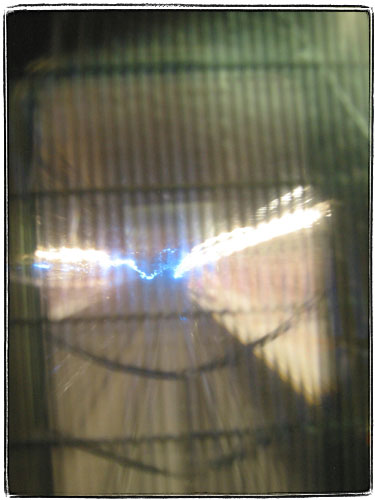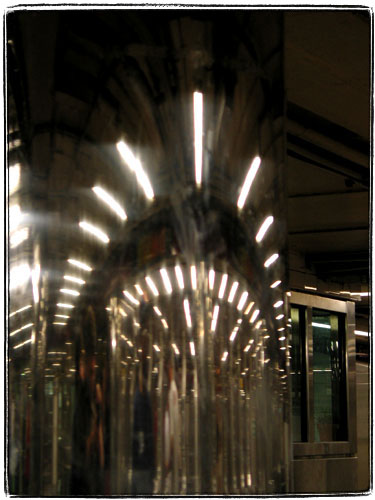October 2004 marks the 100th anniversary of the largest underground transit network in the world. Love it or hate it, if you’re a New Yorker, you can’t live without it: 3.5 million people ride the rails every day. The subway is as much a symbol of New York City as Central Park and the Statue of Liberty. Commemorating its centennial, this official publication presents an illustrated history of the architecture and design of the entire complex, from the interiors of the trains and the mosaic signage at the stations to the evolution of the token and the intricacy of the intertwined, rainbow-colored lines on the free, foldout map.
Produced with the New York City Transit Museum, Subway Style documents the aesthetic experience of the system through more than 250 exclusive pictures. The book includes newly commissioned color photographs of historic and contemporary station ornamentation as well as imagery from the Museum’s archives. The images span the full century, from the system’s inception in the early 1900s up to and including architectural renderings for the still-to-be-built Second Avenue line. AUTHOR BIO: The NEW YORK TRANSIT MUSEUM is one of only a handful of museums in the world dedicated to urban public transportation. The Museum’s collections of objects, documents, photographs, films, and historic rolling stock illustrate the story of mass transit’s critical role in the region’s economic and residential development since the beginning of the 20th century. The Transit Museum’s main facility is located in a decommissioned 1936 subway station in Brooklyn Heights, an ideal setting for the Museum’s 20 vintage subway and elevated cars, and wide-ranging educational programs for children and adults. A gallery annex in Grand Central Terminal presents changing exhibits relevant to the millions of commuters who use mass transit every day.
Photographer Andrew Garn has exhibited his work in galleries around New York City and across the country. His photographs are also held in numerous museum and private collections.
The Legend Of Darius McCollum
I remember reading in papers about a 15 or 16 year old train obsessed kid who faked his way into signing out an MTA train and driving it for a long stretch only to be caught after an automatic switch disabled the train due to speeding. For some reason I thought that the story happened in the early nineties, but it looks like it actually happened much later. I also remember the kid was not punished too strongly and had a chance to work for the MTA.
I always wondered about what happened to him. And as it turned out instead of getting a job at the MTA Darius McCollum had an amazing career impersonating MTA workers and ended up getting a 5 year prison sentence recently.
There was a big long article in Harper’s Magazine about all this:
“Before leaving his girlfriend’s apartment in Crown Heights, on the morning of his nineteenth arrest for impersonating and performing the functions of New York City Transit Authority employees, Darius McCollum put on an NYCTA subway conductor’s uniform and reflector vest. Over his feet he pulled transit-issue boots with lace guards and soles designed to withstand third-rail jolts.”
Ooooh, I want those boots.
Darius spent hundreds of hours watching trains at 179th Street. He estimated the angle of every track intersection in the yard. By the time he was eight, he could visualize the entire New York City subway system. (Later he memorized the architecture of the stations.)
That’s heavy duty Asperger’s for you.
“By this time Darius had cultivated a constellation of admirers at the 179th Street yard. Darius has always been deeply disarming. His charm resides in his peculiar intelligence, his perpetual receptivity to transporting delight, and his strange, self-endangering indifference to the consequences of his enthusiasm. Darius never curses. He has no regionally or culturally recognizable accent. He has a quick-to-appear, caricaturishly resonant laugh, like the laugh ascribed to Santa Claus, and he can appreciate certain comedic aspects of what he does, but he often laughs too long or when things aren’t funny, as when he mentions that he briefly worked on the LIRR route that Colin Ferguson took to slaughter commuters. Darius litters his speech with specialized vocabulary (“BIE incident,” “transverse-cab R-110”) and unusually formal phrases (“what this particular procedure entails,” “the teacher didn’t directly have any set curriculum studies”). He frequently and ingenuously uses the words “gee,” “heck,” “dog-gone,” “gosh,” and “dang.””
I actually know what “transverse-cab R-110” is. It’s one of those newer prototype trains with a full width cab.
“It is unlikely that Darius will omit the year he spent wearing an NYCTA superintendent’s shield. While he was doing a stint as a conductor, he discovered that he could have a shield made in a jewelry store. He began wearing it on a vest he pulled over his TA-specified shirt and tie. He had a hard hat and pirated I.D. Darius considered himself a track-department superintendent, so he signed out track-department vehicles and radios and drove around the city, supervising track maintenance and construction projects and responding to emergencies. “
Amazing. In fact, it looks like he did a pretty good job. But still got some hard time for it.
“”In any event,” Berkman said, “I don’t understand what the point is. … So far as I can tell there’s no treatment for Asperger’s. That is number one…. Number two, Asperger’s would not disable him from knowing that he’s not supposed to form credentials identifying him as an employee of the Transit Authority and go in and take trains or buses or vans or cars or other modes of transportation, which I gather has been his specialty…. “
And I completely agree with the judge.
I Sing The Train Electric

The view from the first car of a train.

The mezzanine of the 34th street station has these really cool reflecting steel columns. No matter how hard I try I can’t capture the myriad of lights reflecting in them.